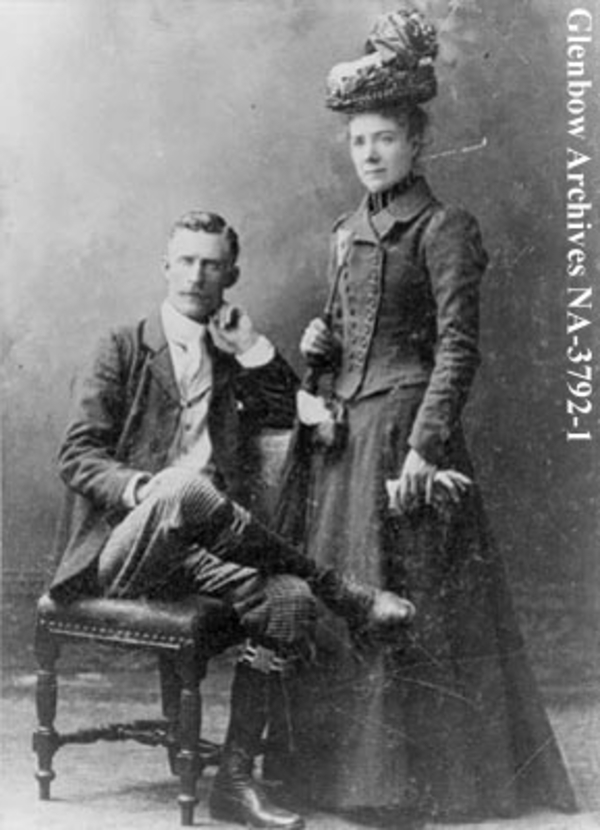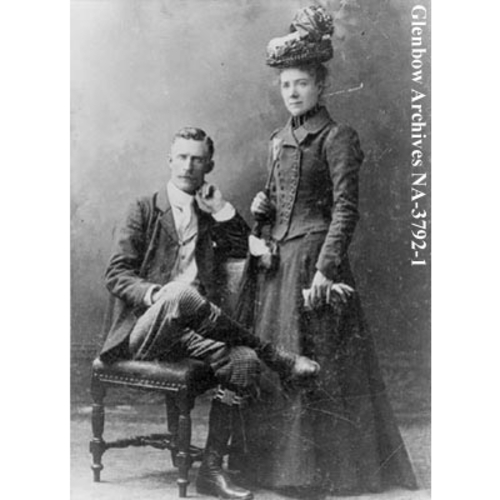
Source: Link
PARTRIDGE, HENRY OSCAR, farmer, teacher, and office holder; b. 6 Oct. 1858 near Dalston, Upper Canada, son of John Thomas Partridge and Martha Chappell; m. first 14 Feb. 1891 Maggie H. Curle (d. 1895) in Sintaluta, Sask., and they had one daughter, who died in 1896; m. secondly 11 July 1900 Ida May King, and they had three children; d. 17 Jan. 1916 in Sintaluta.
Henry Oscar Partridge was one of thousands of young men from rural Ontario who moved to the Canadian prairies after confederation. Part of the first major wave of immigrants to present-day Saskatchewan after the region was opened to systematic settlement under the National Policy, Partridge and two brothers took up homesteads in 1882 near what was soon to become the village of Sintaluta. After fulfilling his settler’s duties by building a sod and pole house and beginning to crop his land, he gradually established himself as a grain farmer who also raised small numbers of cattle and hogs. By the time a map of land tenure was compiled for the Indian Head district in 1906, he possessed three quarter-sections – an average-sized farm in the context of the period and his district.
Like many homesteaders, Partridge took on additional work until his lands were sufficiently developed to demand his undivided attention. On his application for homestead patent in 1887, he characterized his occupation as both farmer and teacher; he had been teaching since 1886. Making do with the district’s limited infrastructure, he had set up a school in an “abandoned log shanty”; he eventually upgraded his provisional certificate to a first-class teacher’s certificate from the Board of Education of the North-West Territories. He taught at the Spring Coulee school until 1891, and in May of that year – at a convention of the Central Assiniboia Teachers’ Association – he presented a paper on “Teacher’s responsibilities” and was elected a member of the executive committee. Though he returned to full-time farming in 1891, he retained a strong interest in education, serving as secretary and chairman of his local school board.
After his teaching career, Partridge supplemented his farming income through various business activities. During the marketing season of 1896 he worked in Sintaluta as a grain buyer for the Winnipeg firm of D. H. McMillan and Company. The following year he was rumoured to be a partner in a new general store then being constructed at Sintaluta. In 1898 he again worked as a grain buyer in the village, this time for the Northern Elevator Company Limited.
Partridge was an early activist in the campaign to make government and commerce more responsive to the community. A member of the first council of the rural municipality of Indian Head, he continued to take a role in grass-roots politics after leaving elective office. In July 1892 he and other settlers petitioned the Indian Head municipal council to submit to electors a by-law to raise $6,000 for the building of two farmer-owned grain elevators, one in Sintaluta and the other in Indian Head. Ratified by the ratepayers and approved by the territorial government, this by-law has been described as “probably the first cooperative effort to handle grain in the District of Assiniboia.” Subsequently, in 1897, he was elected secretary of the Farmers’ Elevator Company at Sintaluta. The same year, at a meeting of local ratepayers called to protest the lack of adequate expenditures in his district, he moved a resolution that a tract be detached from the municipality of Indian Head and reorganized into a statute-labour district – an administrative unit established by the territorial government to facilitate public works. Partridge and a colleague were charged with petitioning the lieutenant governor to implement this change but nothing came of their efforts. The episode demonstrates, however, the vigilance with which rural activists such as Partridge approached issues of local government in the era of early western settlement.
Also in 1897, Partridge was reported as occupying the position of justice of the peace. In 1902 his role as a magistrate occasioned his best-known contribution to public life when he presided over a panel of three jps hearing the first court challenge under the provisions of the Manitoba Grain Act, federal legislation designed to supervise the grain trade throughout the Canadian west. A number of prominent grain officials, politicians, and agrarian activists were in attendance to witness this important test case; they included the warehouse commissioner, Charles C. Castle (the official responsible for administering the Manitoba Grain Act), Thomas Walter Scott*, mp, William Richard Motherwell*, president of the Territorial Grain Growers’ Association, and members of Motherwell’s executive. The case was prosecuted by Thomas Graham Mathers for the federal Department of Justice; Canadian Pacific Railway counsel James Albert Manning Aikins* handled the defence. With his fellow magistrates, Partridge found CPR agent A. V. Benoit, the defendant, guilty of violating those provisions of the act guaranteeing fair access to railway cars for farmers shipping grain; Benoit was fined $50. The verdict was upheld the following year by judge Hugh Richardson of the Supreme Court of the North-West Territories, a judgement that affirmed the capacity of farmers to challenge perceived monopolistic abuses of the grain-handling system.
Following this celebrated case, Partridge continued to contribute to the farmers’ movement, playing a supporting role to his better-known brother, Edward Alexander Partridge*. In 1906 he was secretary to a meeting of farmers at Sintaluta which launched the Grain Growers’ Grain Company Limited, the first farmer-owned grain company operating in the terminal market, and the following year he was elected a director of the Saskatchewan Grain Growers’ Association. Locally, Partridge served as secretary of the Sintaluta branch of the SGGA and, from 1903 to 1907, as president of the Sintaluta Agricultural Society. In 1908 he appeared with a farmers’ delegation before the municipal council of Indian Head to express concern over the way their grain was graded by the Grain Standards Board.
Partridge’s volunteer work in his community also encompassed a number of roles in his local Presbyterian church, including officer, member of the choir, and teacher in the Sunday school. He was evidently an avid sportsman as well. In 1896 he helped reorganize the Sintaluta baseball club, assuming the position of assistant captain. Curling was another of his recreational pursuits. Accomplished in the sport, he served as secretary of the local curling club and emerged victorious at the annual Indian Head bonspiel in 1907. He was among the skips represented at Sintaluta’s first annual bonspiel in 1912.
Henry Oscar Partridge was representative of innumerable persons of modest backgrounds who individually and collectively contributed much to the development of western Canada as a settled agricultural region. Because of limited resources, small communities in the new farming districts of the prairies necessarily relied on the contributions of volunteers to develop much-needed institutions and to improve life for their residents. Partridge was an “active member of every social service and reform movement the community knew,” demonstrating a spirit of service which earned him the respect and gratitude of his fellow citizens.
Agriculture and Agri-Food Canada, Indian Head Experimental Research Station (Indian Head, Sask.), “Map of Indian Head and adjacent district,” c. 1906. Saskatchewan Arch. Board (Regina), R-260 (Dept. of Agriculture, Agricultural Socs. coll.), file no.II.146 (1–3) (returns of the Sintaluta Agricultural Soc., 1903–5); R-E 531 (Olive Partridge Sutherland, geneal. of the Partridge family). Saskatchewan Arch. Board (Saskatoon), Homestead files, 37372, 175328; S-B2 (Saskatchewan Grain Growers’ Assoc.), convention proc., 1902–6. Qu’Appelle Progress (Qu’Appelle, later called Qu’Appelle Station [Qu’Appelle, Sask.]), 1889–22 Dec. 1898, continued as Progress, 29 Dec. 1898–1900. Qu’Appelle Vidette (Fort Qu’Appelle, [Sask.]), 1889–27 Feb. 1896, continued as Vidette (Fort Qu’Appelle and Indian Head; Indian Head), 5 March 1896–99, 1905–6. Regina Leader, 1900–3. Regina Standard, 1900–3. Lyle Dick, “Estimates of farm-making costs in Saskatchewan, 1882–1914,” Prairie Forum (Regina), 6 (1981): 183–201. H. S. Patton, Grain growers’ coöperation in western Canada (Cambridge, Mass., 1928). Tales of the Red Fox: Assiniboine reserve, town of Sintaluta, districts Allindale, Durham, Blackwood, Red Fox & Spring Coulee (Sintaluta, Sask., 1985). L. A. Wood, A history of farmers’ movements in Canada (Toronto, 1924; repr., intro. F. J. K. Griezic, Toronto and Buffalo, N.Y., 1975).
Cite This Article
Lyle Dick, “PARTRIDGE, HENRY OSCAR,” in Dictionary of Canadian Biography, vol. 14, University of Toronto/Université Laval, 2003–, accessed December 14, 2025, https://www.biographi.ca/en/bio/partridge_henry_oscar_14E.html.
The citation above shows the format for footnotes and endnotes according to the Chicago manual of style (16th edition). Information to be used in other citation formats:
| Permalink: | https://www.biographi.ca/en/bio/partridge_henry_oscar_14E.html |
| Author of Article: | Lyle Dick |
| Title of Article: | PARTRIDGE, HENRY OSCAR |
| Publication Name: | Dictionary of Canadian Biography, vol. 14 |
| Publisher: | University of Toronto/Université Laval |
| Year of publication: | 1998 |
| Year of revision: | 1998 |
| Access Date: | December 14, 2025 |



